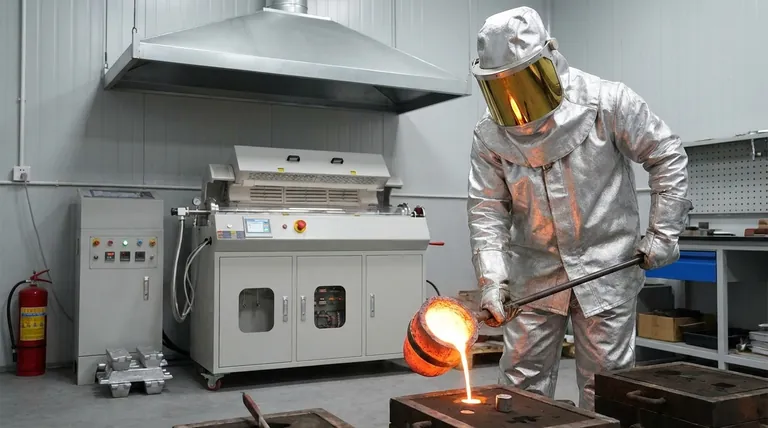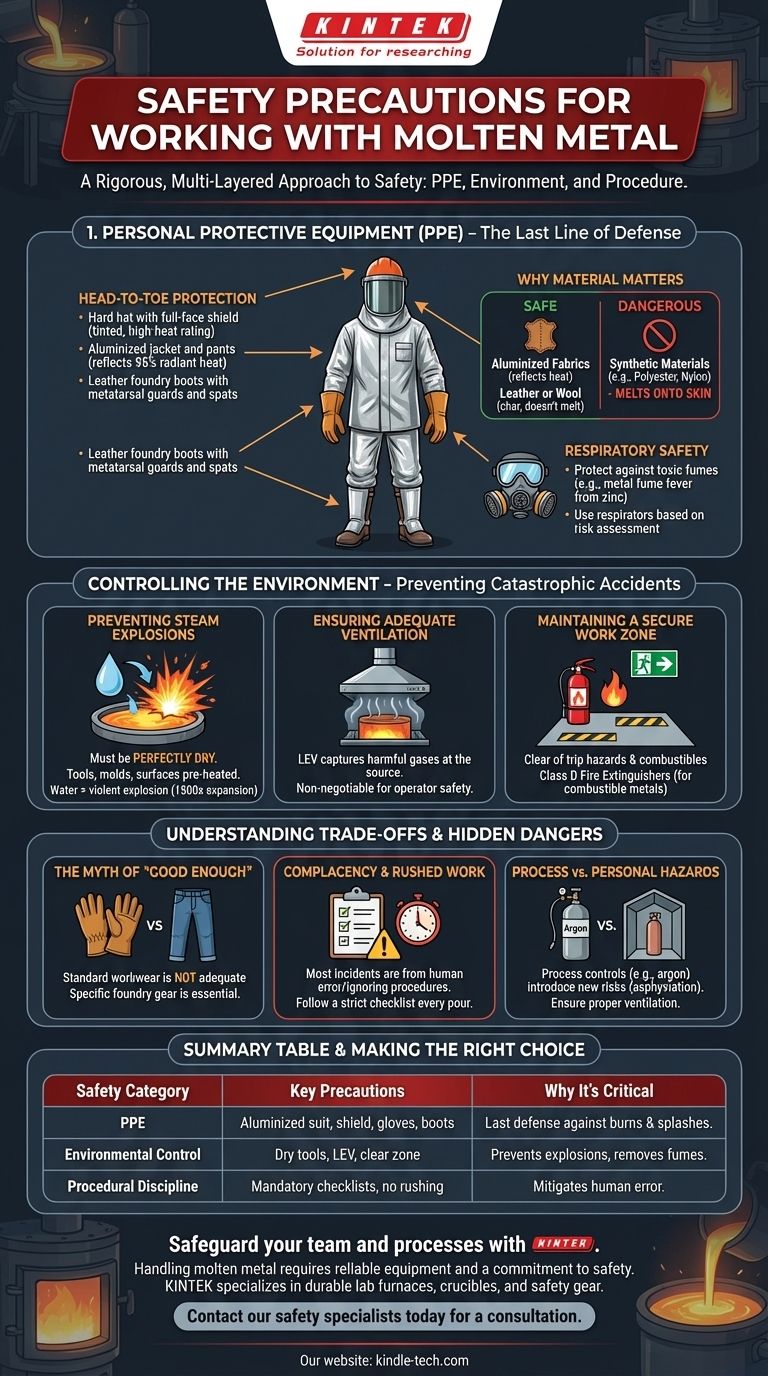Working with molten metal demands a rigorous, multi-layered approach to safety. The most critical precautions involve using specialized Personal Protective Equipment (PPE) to shield against extreme heat and splashes, maintaining a completely dry work environment to prevent steam explosions, and implementing strict, documented procedures for every step of the process. These measures work together as a system to mitigate the severe risks of catastrophic burns, toxic fume inhalation, and violent reactions.
True molten metal safety extends beyond simply wearing the right gear. It is a complete system that integrates personal protection, environmental controls, and disciplined procedures to create a workspace where the immense hazards of liquid metal are respected and managed at all times.

The Foundation: Personal Protective Equipment (PPE)
Personal gear is your last line of defense against the immense energy of molten metal. It must be specifically designed for this purpose, as standard workwear offers little to no protection and can often increase the severity of an injury.
Head-to-Toe Protection
Your primary PPE should cover you completely. This includes an aluminized jacket and pants or a full suit, which reflects radiant heat and sheds splashes.
Essential gear also includes a hard hat with a full-face shield (often with an appropriate shade rating like tinted welding shields), heat-resistant gloves (Kevlar-lined leather is common), and leather foundry boots with metatarsal guards and spats to cover the laces.
Why Material Matters
The material of your gear is critical. Aluminized fabrics are designed to reflect up to 95% of radiant heat, buying you precious seconds to react to a spill.
Natural fibers like leather or wool are flame-resistant and will char rather than melt. Conversely, synthetic materials like polyester or nylon are exceptionally dangerous as they can melt onto the skin, causing severe, deep burns.
Respiratory Safety
Melting metals can release toxic fumes and gases. The specific hazard depends on the alloy being used—for example, melting galvanized steel releases zinc oxide fumes, which can cause metal fume fever.
A proper respiratory protection plan, often involving respirators with cartridges rated for metal fumes, is essential and should be based on a formal risk assessment of your specific materials.
Controlling the Environment
Your surroundings can be as hazardous as the metal itself. A controlled environment is designed to prevent the most common and violent types of accidents.
Preventing Steam Explosions
This is the single most catastrophic risk. When molten metal comes into contact with even a small amount of trapped moisture (water, condensation, or even sweat), the water flashes to steam instantly, expanding to over 1,500 times its original volume.
This causes a violent explosion that can throw molten metal across an entire workspace. All tools, molds, and surfaces must be perfectly dry and, ideally, pre-heated before coming into contact with the melt.
Ensuring Adequate Ventilation
Proper ventilation is non-negotiable for removing harmful gases and fumes from the operator's breathing zone.
Local Exhaust Ventilation (LEV), such as a fume hood directly over the furnace or pouring area, is the most effective method as it captures contaminants at their source before they can spread.
Maintaining a Secure Work Zone
The area around the furnace and pouring floor must be kept clear of all trip hazards and combustible materials. Emergency exits must be unobstructed.
Having fire extinguishers rated for Class D (combustible metal) fires is also a critical requirement, as water-based extinguishers will cause a steam explosion.
Understanding the Trade-offs and Hidden Dangers
Relying on just one aspect of safety creates a false sense of security. It's crucial to understand the limitations and hidden risks in the process.
The Myth of "Good Enough" PPE
There is no substitute for gear specifically designed for foundry work. Standard leather gloves, work jeans, or safety glasses do not provide adequate protection from the intense radiant heat and splash hazards of molten metal.
Complacency and Rushed Work
The vast majority of incidents occur not from equipment failure, but from human error when established procedures are ignored. Familiarity can lead to complacency, making adherence to a safety checklist for every single pour an absolute necessity.
Process Hazards vs. Personal Hazards
Protecting yourself is different from protecting the quality of your metal. Techniques like adding flux powder or using an argon shrouding gas are designed to prevent the molten metal itself from oxidizing.
While these process controls are vital for a good result, they can introduce new hazards. An inert gas like argon, for example, can displace oxygen in an enclosed space, creating a serious asphyxiation risk that must be managed with proper ventilation.
Making the Right Choice for Your Goal
Implementing a robust safety protocol requires a systematic approach that prioritizes hazards based on your specific situation.
- If your primary focus is setting up a new workspace: Prioritize engineering controls first; ensure you have excellent ventilation and a dedicated, dry, and uncluttered pouring area free of all moisture.
- If your primary focus is selecting personal gear: Invest in a complete, purpose-built PPE kit made from aluminized or specialized leather materials, and ensure it covers you from head to toe.
- If your primary focus is refining your procedures: Document every step, from pre-heating tools to pouring and cleanup, and treat this checklist as a mandatory part of every single operation.
Ultimately, a disciplined and comprehensive approach is the only way to safely harness the power of molten metal.
Summary Table:
| Safety Category | Key Precautions | Why It's Critical |
|---|---|---|
| Personal Protective Equipment (PPE) | Aluminized suit, face shield, heat-resistant gloves, leather boots. | Last line of defense against extreme heat and splashes; prevents severe burns. |
| Environmental Control | Dry tools/molds, local exhaust ventilation, clear work zone. | Prevents catastrophic steam explosions and removes toxic fumes. |
| Procedural Discipline | Mandatory checklists, no rushing, understanding process hazards. | Mitigates human error, the leading cause of accidents. |
Safeguard your team and processes with KINTEK.
Handling molten metal requires reliable equipment and a commitment to safety. KINTEK specializes in supplying durable lab furnaces, crucibles, and safety gear designed for high-temperature applications. Our experts can help you select the right tools to build a secure and efficient workspace.
Contact our safety specialists today for a personalized consultation. We'll help you identify the right equipment and consumables to protect your personnel and ensure the integrity of your materials.
Visual Guide

Related Products
- Rotary Tube Furnace Split Multi Heating Zone Rotating Tube Furnace
- Vacuum Sealed Continuous Working Rotary Tube Furnace Rotating Tube Furnace
- Laboratory Vacuum Tilt Rotary Tube Furnace Rotating Tube Furnace
- 1400℃ Laboratory Quartz Tube Furnace with Alumina Tube Tubular Furnace
- Laboratory Muffle Oven Furnace Bottom Lifting Muffle Furnace
People Also Ask
- What is a rotary heat type furnace? The Ultimate Guide to Uniform Heating & Mixing
- What is a rotary retort furnace? Achieve Superior Uniformity in Continuous Heat Treatment
- What are the advantages and disadvantages of rotary furnace? Maximize Uniformity & Efficiency in Thermal Processing
- What are the typical heating zone configurations and maximum temperature capabilities of tube furnaces? Find the Right Setup for Your Lab
- What is the process of zirconium production? From Ore to High-Performance Metal & Ceramic



















